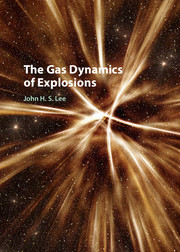Book contents
- Frontmatter
- Contents
- Preface
- 1 Basic Equations
- 2 Weak Shock Theory
- 3 Shock Propagation in a Non-uniform Cross-sectional Area Tube
- 4 Blast Wave Theory
- 5 Homentropic Explosions
- 6 The Snow-Plow Approximation
- 7 The Brinkley–Kirkwood Theory
- 8 Non-similar Solutions for Finite Strength Blast Waves
- 9 Implosions
- References
- Index
7 - The Brinkley–Kirkwood Theory
Published online by Cambridge University Press: 05 June 2016
- Frontmatter
- Contents
- Preface
- 1 Basic Equations
- 2 Weak Shock Theory
- 3 Shock Propagation in a Non-uniform Cross-sectional Area Tube
- 4 Blast Wave Theory
- 5 Homentropic Explosions
- 6 The Snow-Plow Approximation
- 7 The Brinkley–Kirkwood Theory
- 8 Non-similar Solutions for Finite Strength Blast Waves
- 9 Implosions
- References
- Index
Summary
Introduction
The description of the propagation of non-steady shock waves requires the integration of the partial differential equations for the flow behind the shock subject to the boundary conditions at the shock and at some rear boundary. Since the shock velocity is not known, the numerical solution is not straight forward. There are practical problems where a complete description is not required, and only the variation of the shock strength with position is desired. Thus there is a need for approximate methods of solution for the shock front only. During the early 1940s, Kirkwood and Brinkley (1945) and Brinkley and Kirkwood (1947) developed a simple method to describe blast waves in water and air. They derived a simple “shock front evolution equation” which gave surprisingly good predictions for the blast wave decay in air and water. Brinkley and Kirkwood (henceforth referred to as BK) derived a pair of ordinary differential equations for the variation of the shock strength and the blast energy with shock radius from the conservation equations, the Rankine–Hugoniot conditions at the shock front, and the energy integral. The unique feature of the BK theory is the formulation of the blast energy integral. The blast energy is defined as the sum of the kinetic and internal energy between the shock front and a particle path which acts like a piston. The blast energy is then equated to the work done by the particle path. Since no mass crosses a particle trajectory, it is essentially a solid expanding piston that displaces the fluid ahead of it. When time is taken to infinity where all motion ceases, the total work done is manifested as the residual internal energy in the shocked fluid. The residual internal energy also corresponds to the energy dissipated by the shock wave. The BK theory recognizes the finite entropy increment of the fluid particle that crosses the shock wave. The energy dissipation reduces the available energy of the shock wave and results in its decay. Thus the BK theory addresses explicitly the mechanism of shock decay.
Descriptions of the BK method, described in the wartime NDRC reports and in the Physical Review paper by Brinkley and Kirkwood, are rather brief and difficult to follow.
- Type
- Chapter
- Information
- The Gas Dynamics of Explosions , pp. 121 - 135Publisher: Cambridge University PressPrint publication year: 2016



